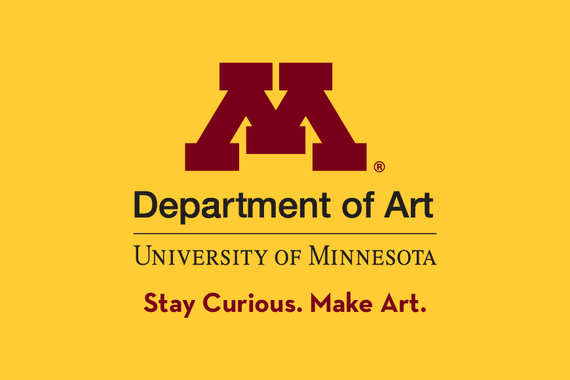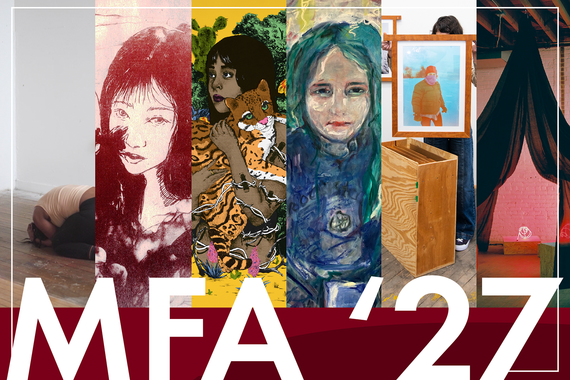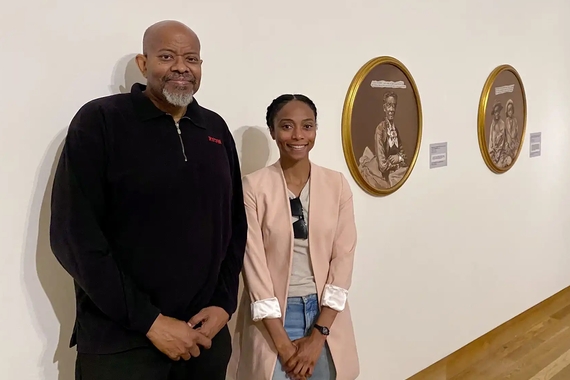Guggenheim Fellowship Allows Professor Chris Larson to Dig Into A History of Labor
Sitting in the Purple Onion Cafe on University Avenue, multimedia artist and Associate Professor Chris Larson pauses a moment to observe his surroundings. “It’s about double—no, probably triple this size,” he says. “No natural light, though. It’s all fluorescent.”
Larson is describing a 20,000 square foot abandoned garment factory in Smithville, Tennessee, where he has spent the last three months. “It’s an odd space for an artist to go into,” he admits, but it's not odd for Larson. His most recent projects centered around architectural sites with a focus on history and location. His proposal to investigate this particular basement factory earned him a 2018 Guggenheim Fellowship.
A Story in Smithville
It was only a year and a half ago when Larson discovered the sewing factory about an hour outside of Nashville. In Smithville, where the population is just shy of 5,000 and the median income is $26,000, the factory sits abandoned, having opened its doors in 1950 only to close them in 1998 when its labor was outsourced. Sporting seven-foot tall ceilings and not a single window, the factory floor remains untouched since its closure. Larson has counted 50,000 spools of thread and countless zippers and tags in the three months he has spent there. Initially, his interest in “the residue of labor” that had been left behind and preserved was what drew him to the factory. “I was curious about the places that we work,” Larson states simply.
His curiosity led him to speak to a few people who used to work in the factory, some of whom now work in a different factory one floor above the basement. In its heyday, the sewing factory employed about 300 women, who worked more than forty hours a week, sometimes six days a week. As Larson notes, “that represents a lot of labor—that’s millions of hours of labor.” That thought is echoed in the sewing machines still there, many of which, in the aftermath of millions of fabric layers processed during a forty-eight-year tenure, have had the paint worn off of their bases.
And yet, Larson has also found that the basement factory was the coolest place in Smithville; the building had such strong air conditioning that some women reported working in sweaters during the summer. Larson was also surprised to find that the large round speakers spotted throughout the basement weren’t for workplace communication, but for playing a constant stream of country music. The factory is “loaded with heaviness,” Larson notes, referencing the sheer amount of human labor it once housed, “but there’s a lot of towns like this across America.”
A Grant From the Guggenheim
Earning a Guggenheim Fellowship is a process. An artist’s application and three letters of recommendation go through an initial round of cuts. Then, images of their work are provided for the committee to review before reaching out to various people who act as mentors to the artists to write letters on their behalf. 2018 marked the 12th year that Larson had applied for the prestigious standing.
“If you get to that level, they trust what you can do with that funding,” he says. “It’s the most freedom you will ever get with a fellowship.” Larson’s freedom came in the form of the $55,000 Guggenheim grant for his proposed abandoned sewing factory project. Further details of the project have yet to be fully hashed out, but for Larson, that isn’t a concern; that’s just the process. “There are so many arms and legs to this project,” he says. “[The final product] could be a performance, sculpture, drawing, maybe even an album recording of songs. I like putting myself in these situations where I don’t know what’s going to happen.”
Despite his Guggenheim proposal estimating that the project would only take a year, Larson thinks it might take a couple more to see it through to the end. “I can’t see any light at the end of any tunnel,” he says, “And sometimes there is no tunnel.” In the meantime, Larson is in the basement “playing with things and documenting things,” much to the delight of the current workers above him. “They know I’m down there, they know I’m an artist with a funny-sounding scholarship, but their idea of what I’m doing down there is more along the lines of ‘Are you painting a painting down there?’ I think it’s beautiful that their idea is that I’m down there trying to represent it all with a drawing.”
Persistence Makes Process
Larson’s five most recent projects dealt with significant historical places, focusing on time and place. His project called “Deep North” commemorated an intense ice storm he experienced in Switzerland. It was an installation where he rebuilt a shotgun house, only to freeze it inside and out by spraying it with hundreds of gallons of water in the dead of February. “Land Speed Record” became a tribute to Hüsker Dü band member Grant Hart by showcasing belongings that had been retrieved from his childhood home after a fire. “Wise Blood” was an immersive opera-exhibition that brought Flannery O’Connor’s novel of the same name into a tangible realm for its audience. “I love manipulating architecture and making it fluid,” Larson explains. “I can see threads that combine these different projects and different interests...Even the stories of workers are just as important as a rock drummer or as important as an abandoned shotgun house in New Orleans.”
Larson’s commitment to a slow, natural process has driven his work throughout the decades. He believes in what he calls “the slow build,” a lifetime’s accumulation of knowledge, work, and process, all interwoven. This commitment to process has led Larson to say yes to every show he has been invited to. “I tell students all the time,” he reveals. “to never turn down a show. There will be a time when nobody cares about your work… I feel grateful and fortunate that anybody has paid attention to me and given me experiences and shows. I want to keep showing until I’m dead.”
Larson affirms that he is trying to not get too comfortable and not be afraid to fail. “Nothing might come from this project,” he says shrugging. “But at the very least, I’m going to learn something about my practice. Sometimes it's more important to learn what you're not than it is to have anything come out of a project.”
This story was written by an undergraduate student in CLAgency. Meet the team.



